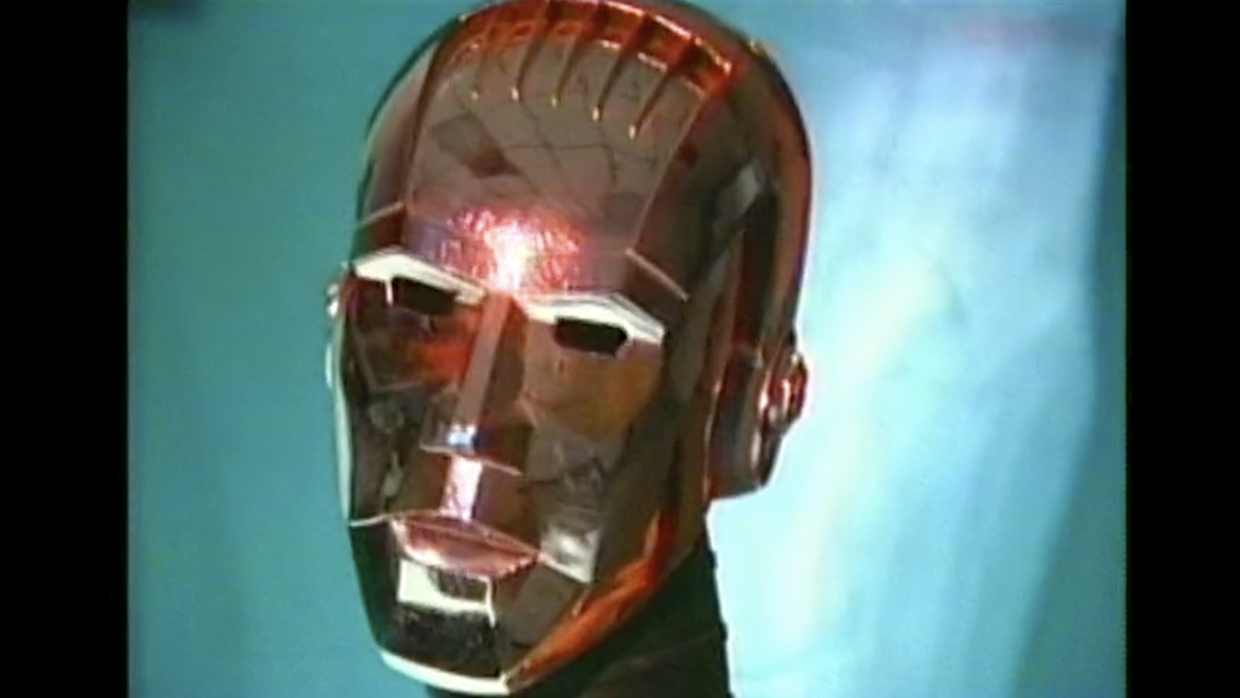 NightLight
NightLight In 1986, ia Kamandalu showed up at the EZTV space in West Hollywood for a screening of video art by Doris Chase. People recognized her, even though it had been a few years since she was a dancer in music videos like “Super Freak” by Rick James and on variety shows like Don Kirshner’s Rock Concert, performing at the time under the name Kim McKillip. Michael Masucci, an artist and longtime participant in the EZTV community of video-makers, started talking to her. They kept up over the phone and made plans to work together. Kamandalu, who was living Phoenix at the time, flew in several times and slept on her grandmother’s couch while they filmed Lemuria (1986), a short enigmatic choreography and music-driven piece. It was the first of their collaborations as the video art duo, Vertical Blanking.
All of this was to the best of Masucci’s memory when I interviewed him in his studio this spring. Kamandalu drifted away and no one he knows has seen her in years. “Amicably,” he insists. Ordinarily, I would reach out to confirm places and dates, for basic fact-checking, but I’m also not in the practice of tracking down people who, amicably, would prefer not to be found. Videos they made together, including Lemuria, screened at REDCAT in March, kicking off an eight-day EZTV retrospective across multiple venues in Los Angeles with future events scheduled in New York this August.
At the REDCAT screening, I was struck by the uninhibited liveliness that comes through in the Vertical Blanking videos. Performance art pieces captured in experimental video techniques tunnel viewers into fleeting moments of spontaneous energy. Two stands outs, Deposition (1991) and NightLight (1992) emerged from Masucci and Kamandalu’s research in ufology and conversations they had with “experiencers.” In NightLight, impressionistic footage of Kamandalu is juxtaposed in quick cuts to bizarre images including a very shiny robot.
If I had gone another night in the EZTV retrospective curated by Elizabeth Purchell and the nonprofit screening series Hollywood Entertainment, I would have encountered an entirely different style of video work. The projects that were incubated at EZTV spanned from digital art to documentaries to lesbian erotica to ultra low budget horror features to the hard-to-categorize performance art videos that Vertical Blanking pioneered.
The robot in NightLight came from a friend of the EZTV community who regularly salvaged old sci-fi movie props from junk yards. (One treasured find was the spaceship from My Favorite Martian, which Masucci and Kamandalu took to Earl Scheib for a new paint job). Much of the equipment landed at EZTV just the same: as donation or loan, then repurposed or borrowed or loaned out once more. Its West Hollywood headquarters had been a screening room and exhibition space, with editing bays, classes, production facilities, and other community functions. The space was predominantly run by gay men, including John Dorr, who founded EZTV, but it was open to all fellow travelers. Anyone who wished to make any sort of work on video was welcome.
In a short documentary on EZTV for a local broadcast in 1992, Dorr reflected on the first video he directed, SudZall Does it All! “It was made for fifty dollars,” he said. “A feature-length documentary that you could show to people. I thought, ‘That’s revolutionary, that’s mind-boggling: if enough people did that, it would be like a parallel universe to Hollywood.’”
Welcoming by default rather than gatekeeping, EZTV was untethered by Hollywood studio system baggage: homophobia and other bigotries, pursuit of mainstream acceptance, and the glacial pace of production—not to mention, any need for massive crews, big budgets, and highly coordinated logistics. The fusion of energy and generosity of spirit seemed to bubble out of proximity. “Hollywood had to exist, symbolically but also materially, with its overproduction of talent and skill,” the art historian Julia Bryan-Wilson wrote in a 2014 journal article for Grey Room. “Video-makers affiliated with EZTV were able to mobilize the talents, expertise, and abilities of underemployed Hollywood editors, technicians, camera operators, and actors.”
This through-the-looking glass version of Hollywood realized by EZTV came complete with a West Hollywood sign in big white letters, which Masucci constructed on a tiny hill above a parking lot in 1986. It was much smaller, of course, but the sign could be mistaken for the famous landmark if an image was cropped the right way.
Masucci now laments how Kamandalu was credited in their first collaboration as a “performer.” From the beginning, he said, Vertical Blanking had been a “complete partnership,” but still, the credits “started out in the old hierarchical male director” way. He’s been in this role, speaking for people who aren’t around any more—and apologetically about it—for decades now. The EZTV community was gutted by the AIDS pandemic. John Dorr died on New Year’s Day, 1993. Masucci is now in the position of imperfectly communicating its institutional legacy as “straight cisgender guy,” albeit one who has been “fascinated with the social movement that was happening within gay liberation and feminist work.”
He had a partner in this, Kate Johnson, who first entered his life to help finish one of Dorr’s projects after his passing. The media artist then became essential part of EZTV creating new work for the organization, which moved to the 18th Street Arts Center in 2000. She steered its archive and preservation practices. As Masucci put it, from the beginning Johnson “fell in love with people she never met” and committed herself to keeping EZTV and its legacy alive. Then Johnson died in 2020. (The last time he spoke with Kamandalu was when she called with condolences).
Many of these videos are now part of ONE National Gay & Lesbian Archives, which the EZTV series programmers Purchell and Alex Gootter of Hollywood Entertainment scoured in addition to old hard drives from surviving members of the community.
Purchell and Gootter are especially interested in EZTV as programming space, a precursor to contemporary microcinemas like Whammy! in LA and Spectacle in Brooklyn. But what sets EZTV apart to this day, said Gootter, is how the programming extended broadly “not being inhibited by genre or scene or discipline.”
“We really tried to be as comprehensive as we could in our series,” said Purchell. But “there is no way to do a complete comprehensive series on them because the organization has been so many different things over the years.”
That they are able to approximate the breadth of EZTV programming is due to a decades long effort by surviving members to hold on to the physical media. Masucci told me about tapes he and other friends had to grab from the dumpsters after Dorr died. “We think we got almost everything, but there’s no doubt stuff that got away,” he said.
Those tapes had been collecting dust in boxes and in closets before they arrived at ONE Archives. It was important to Masucci to hold on to as much of everything that was ever made at EZTV: the art, the porn, the documentaries, the trash.
The organization might have more swiftly attained art world prestige with an archive that focused just on the group’s experimental video side. “We understood that preserving everything did have a cost to us,” he told me. But that was the true spirit of EZTV: its scrappiness, motley and unexpected uses of video had to be preserved.
“We could have completely retold [our story],” he said. “But we were always everything.”


